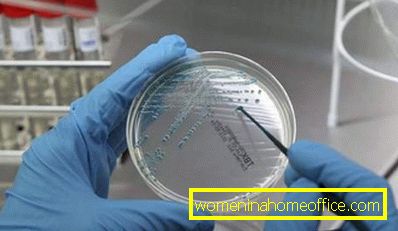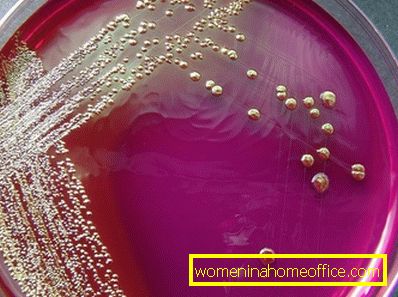E. coli in a smear in women
The human body inhabits many different bacteria. Among them are beneficial bacteria that support the normal functioning of our intestines. These are all known lactobacilli, bifidobacteria and E. coli. It is about her and will be discussed in our article.
E. coli: habitat

E. coli was isolated by Austrian scientist Escherich back in 1885. Today, many species of this bacterium are well known: many of them are harmless to the body and are a necessary component of the intestinal microflora. In addition, E. coli synthesizes vitamins K, B1, B2, B3, B5.
However, there are more than 100 species of this bacterium, which are pathogenic and can provoke the development of serious diseases or poisoning. It is worth noting that even bacteria that are conditionally pathogenic (such as hemolyzing E. coli, for example), can cause serious complications if they are ingested from other organs of the human body.
The presence of E. coli in a smear in women: causes, symptoms and treatment
The normal habitat of this microorganism is the area of the colon, located closer to the anus. First you need to understand how E. coli enters the vagina and how to detect it.
In general, in small quantities E. coli in the vagina may be present, but its reproduction leads to bacterial vaginosis and other diseases.
Causes of E. coli entering the vagina
There are several reasons for this microorganism to enter the vagina:
- Non-compliance with the rules of personal hygiene, namely improper washing. Due to the proximity of the vagina and anus, in order to prevent the introduction of pathogenic microbes, you need to wash down from the top down, and not vice versa.
- Wrong choice of underwear. Various microbes and bacteria from the anus, including E. coli, may enter the vagina due to wearing of strings and tight linen. Thongs are definitely beautiful and sexy. But choosing between beauty and health, it is better to prefer the latter. You should also give preference to underwear made from natural cotton fabrics.
- Unprotected intercourse. Here we are talking about combined sexual intercourse, that is, anal-vaginal. So lovers to diversify their sex life should first think about the means of protection.

In addition, the reasons contributing to the ingress of E. coli in a smear include indiscriminate change of sexual partners, frequent douching, weak immunity.
Symptoms of pathology
The presence in the vagina of E. coli can cause the development of such diseases of the female genital organs, such as:
- adnexitis;
- bacterial vaginosis;
- endometritis, etc.
The development of the above pathological conditions of the female body is accompanied by the following symptoms:
- discharge abundant and have an unpleasant smell;
- tormenting itching and burning sensation in the genital area.
In the absence of proper treatment, Escherichia coli from the vagina easily penetrates into the cervical uterus, ovaries, as well as into the urethra, bladder and then affects the kidneys.
Treatment methods
If signs of the presence of E. coli were identified in a vaginal smear, this is a serious reason for the early initiation of treatment. After all, the more neglected the disease, the more difficult it will be to fight and the more forces the body will need to recover.
Of course, only a doctor can write treatment in detail. As a rule, the patient is credited with taking antibiotics. However, some types of E. coli are resistant to the action of certain drugs, and this must also be taken into account.

In addition to drug treatment, specialists usually prescribe the following procedures:
- washing the genitals with grass decoctions (for example, chamomile);
- in some cases, appoint sessions of UV irradiation of the genital organs;
- various therapeutic douches;
- the use of drugs to restore microflora: probiotics, bio-yoghurts;
- taking complex vitamins to strengthen the immune system.
After the treatment, the tests must be resubmitted.
What happens if E. coli is found in a smear during pregnancy?
Separately, I would like to say about the possible consequences of the detection of E. coli in a smear in pregnant women. Since during this period the immunity is greatly weakened, the threat of the emergence of various kinds of infections is higher than ever. There is a risk of its penetration through the placenta and infection of the child, and this is fraught with the development of meningitis in the baby, which in itself sounds almost like a sentence.
In addition, the child may become infected, passing through the birth canal of the mother. Also, the consequence of vaginosis (diseases provoked by E. coli) can be premature birth.
Of course, antibiotics will not bring much benefit to the child either. But with timely treatment, the doctor will be able to pick up the type of drugs that will be safe for the further development of the fetus.
In general, in order to avoid problems when planning pregnancy, it is better to pass a smear out of the vagina in advance for research and to eliminate all possible infections. This will greatly facilitate the life of you and preserve the health of your future baby.

Preventive measures
In order to prevent E. coli from entering the vagina, a number of fairly simple rules should be followed:
- wash at least 2 times a day;
- change your underwear daily;
- take seriously the choice of underwear: wear only panties from natural fabrics;
- during sex use condoms.
As you can see, E. coli can create many problems for a woman. But even if it is found in your smear, you should not panic. The main thing - do not delay the campaign to the doctor and do not self-medicate.